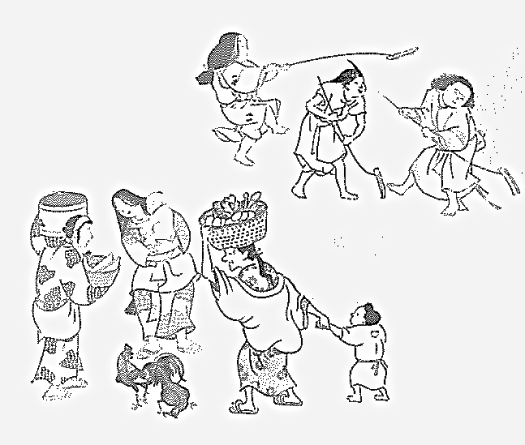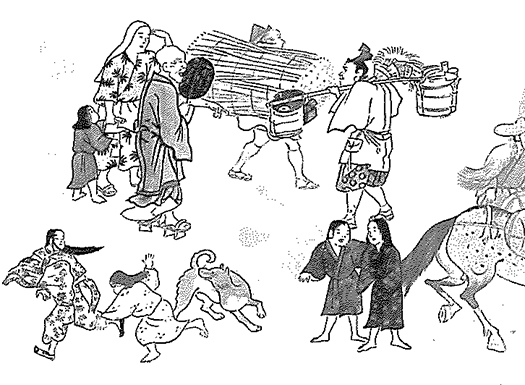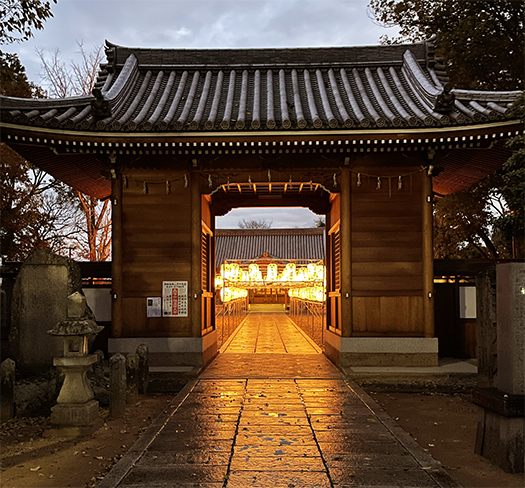


先日来、何度も重なってきた広島県東部「福山」周辺探訪の余韻のなかに耽溺しております。どうも現世のことよりも、歴史時間のなかにこころを揺らがせている方が好ましい心理。
広島県立歴史博物館(福山)では草戸千軒遺跡の復元展示があったり、その図録はなぜか2冊も購入していて、なんども繰り返し見続けています。あ、2冊あるのは、隔年での再訪時にもうすでに購入していたことを失念していて購入してしまったのです。もう初訪問から20年近く経っていますが、ジオラマの世界とこの図録に収録されている「民」の生き様に耽溺しているのです。
上のイラスト画は「一遍上人絵伝」(国宝)から。鎌倉期の成立とされる絵伝で、伊予の河野氏の一族であった一遍上人が、踊り念仏の大衆向け仏教宗派を開闢して、全国を行脚していた様子を表現したもの。〜一遍の異母弟(一説には実弟または甥)でその弟子ともいわれる聖戒がその報恩のために作成した。奥書には、1299年(正安元年)一遍の弟子にあたる聖戒が詞書を起草し、法眼の地位にあった画僧の円伊が絵を描いた〜Wikipediaの記述。
その画面には当時の子どもたちの様子が描かれていて、そのポーズや体動作で示されている表情になんとも深く癒される。柳田國男さんの著作を読んでいると、子どもというのは、この世での魂魄・生き様が明瞭に刻印されていない、という存在であって、民俗的な家意識からはまだ未熟なものとして認識されている様子が記述されている。その時代の空気に十分に満たされていない「天真爛漫」ぶり。しかしそこに民族の共通性が正直に表れていると思える。
最後の写真は播州・姫路の英賀神社の「夜景」。現代社会では夜の歓楽街が現代人の「アジール」の象徴とも思えるけれど、この写真のような光景からも、そういったものと通底するような空気感が漂ってくる。
なにか、列島社会でこういう人びとの生きてきた空間性・生き様というものに「かえっていく」気分がだんだんと強くなっています。
English version⬇
[Folk azure, ancient ‘pictorial’ expressions].
I love it and am made to keep watching its movements and expressions repeatedly. These ‘children’s minds’ invite us from history with a smile. I love the space and time. …
Since the other day, I have been indulging in the lingering memories of my many visits to the Fukuyama area in eastern Hiroshima Prefecture. I prefer to let my mind wander in the historical time rather than in the present world.
At the Hiroshima Prefectural Museum of History (Fukuyama), there is a restored exhibition of the Kusado-Senken site, and for some reason I have bought two copies of the catalogue, which I keep looking at over and over again. Oh, the reason there are two copies is that I had already bought them when I revisited the museum every other year, because I had forgotten that I had already bought them. It has been almost 20 years since my first visit, but I am still indulging in the world of dioramas and the way of life of the ‘people’ included in this catalogue.
The illustration above is from the ‘Ippen Shonin Eiden’ (National Treasure). The illustrated biography, which is said to have been established in the Kamakura period, depicts how Ippen Shonin, a member of the Kono clan of Iyo, created a Buddhist sect for the masses that practised dancing Buddhist chanting and travelled around the country. 〜It was created by Ippen’s half-brother (or, according to one theory, his own brother or nephew) and disciple, Shōkai, as a way of repaying his kindness. The inscription in the back says that in 1299 (the first year of Shoan), Seikai, a disciple of Ippen, drafted the lyrics, and En’i, a painter and monk of the Dharma eye, painted the pictures.
The screen depicts children of the time, and the expressions shown in their poses and body movements are very deeply soothing. In reading Kunio Yanagida’s writings, he describes children as beings whose soul spirit and way of life in this world have not been clearly imprinted, and who are still recognised as immature by the folk family consciousness. They are ‘naïve’ and not fully in tune with the atmosphere of the times. However, the commonality of the people seems to be honestly expressed there.
The last photograph is a ‘night view’ of Eiga Shrine in Himeji, Banshu. In modern society, night-time entertainment areas can be seen as a symbol of modern people’s ‘asylum’, but the scene in this photo gives off an atmosphere that has something in common with such places.
I am gradually getting the feeling that I am ‘returning’ to the spatiality and way of life that these people have lived in the archipelago society.
Posted on 1月 7th, 2025 by 三木 奎吾
Filed under: 日本社会・文化研究







コメントを投稿
「※誹謗中傷や、悪意のある書き込み、営利目的などのコメントを防ぐために、投稿された全てのコメントは一時的に保留されますのでご了承ください。」
You must be logged in to post a comment.